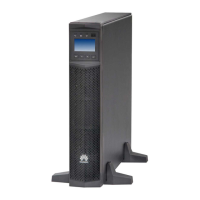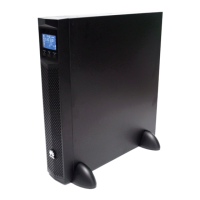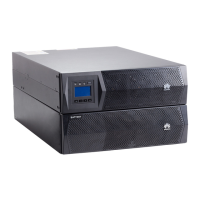Cables are routed properly according to engineering
requirements.
All cables are connected securely and correctly, and they are free
of damage. Bolts are tightened to specified torque using a torque
wrench.
Cable connection to USB,
network, and other ports
Signal cables to USB, network, and other ports are connected
securely and correctly.
Labels are neatly attached to both ends of each cable, and the
information on the labels is concise and legible.
The UPS ground cable is securely connected to the equipment
room ground bar. Use a
multimeter to measure the resistance
between the UPS ground cable and the equipment room ground
bar. The resistance is less than 0.1 ohm.
Spacing between cable
ties
Distances between cable ties are the same, and no burr exists.
The inside and outside of the cabinet are free from conductive
dust or other sundries.
Verifying the Installation
4
Operations
5
1. Switch on the external battery circuit breaker (if any).
2. Switch on the external AC input circuit breaker (if any). The UPS enters standby mode.
3. Press and hold SELECT for 1s on a non-setting screen to access the login screen for parameter
settings. The initial password is 123. Enter the correct password to access the UPS setting
mode. On the parameter setting screen, press SELECT to select a parameter, and then press
OFF/ENTER. Set parameters as required.
Default output voltage: 230 V AC; options: 220 V AC, 230 V AC, and 240 V AC
Default output frequency: 50 Hz; options: 50 Hz and 60 Hz
Default battery capacity: 4 (200 Ah), 1 (50 Ah) to 48 (2400 Ah). The value increases by 50 Ah
each time you press SELECT.
Default number of parallel UPSs: 1; value range: 1–4
Setting Key UPS Parameters
5.1
All manuals and user guides at all-guides.com

